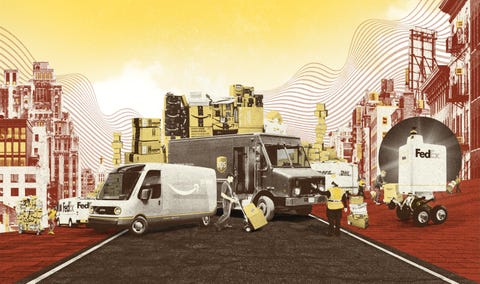
Illustration by Ryan OlbryshCar and Driver
E-commerce sales rose by 49 percent in the United States in April. So while street traffic might be down all over, package traffic is way up since this was originally written. And it turns out toilet paper wasn’t so easy to buy after all.—Ed.
From the May 2020 issue of Car and Driver.
It turns out that the convenience of buying anything—toilet paper, toilet brushes, toilets—with a single tap from the comfort of your porcelain throne isn’t without inconvenience in major cities. Because of our online-shopping habits, delivery vehicles are stacking up in urban areas like cardboard boxes in a dumpster.
E-commerce has more than doubled in the past decade, growing from 4.6 percent to 10.7 percent of U.S. retail transactions. The corresponding rise in home deliveries—Amazon’s network alone transported more than 3.5 billion packages globally last year—is clogging city streets with trucks that stop frequently and often park illegally. While trucks make up 7 percent of traffic in major cities nationwide, they’re responsible for an outsize 11 percent of congestion, according to the 2019 Urban Mobility Report from the Texas A&M Transportation Institute.
The effects have been profound in dense cities like New York. According to a recent New York Times analysis, daily package volume to households in the Big Apple tripled from 2009 to 2017 while the amount of physical space for the ubiquitous white, blue, or brown delivery vehicles remained static. Drivers have resorted to taking over street corners with their trucks, sorting packages on sidewalks as they conscript public space for private industry. They don’t always get away with it, though. New York City handed UPS a bill for $ 33.8 million for parking fines in 2018 and gave FedEx one for $ 14.9 million.
And it’s likely to get worse. FedEx expects the number of packages delivered in the U.S. to double by 2026, to 100 million per day, with 90 percent deriving from e-commerce and the overwhelming majority of this volume going to residences. The solutions for reducing delivery traffic are as far-fetched as anything the autonomy- and drone-loving tech industry has come up with.
For now, the companies making a buck on the delivery boom are doubling down. FedEx recently expanded its residential service to seven days a week and added nearly 3000 vans to its fleet, and Amazon has ordered 100,000 electric vans from startup automaker Rivian. But like loosening a belt to cure obesity, having more delivery vehicles only worsens the problem. It guarantees that the cost of shipping remains low and the packages—and the trucks—just keep coming.
Thinking Outside the Box
FedEx’s experimental lidar- and camera- equipped electric delivery bot, called Roxo, proposes a future where urban delivery traffic moves from the streets to the sidewalks. Roxo weighs 200 pounds, can carry 100 pounds, and is capable of climbing stairs, making it an outlier among delivery drivers. What’s more, in the suburban town of Christiansburg, Virginia, the company has tested a flying delivery drone, developed with Wing, that drops small packages mere steps from a recipient’s front door.
Want more Car and Driver?
Subscribe Now!
This content is created and maintained by a third party, and imported onto this page to help users provide their email addresses. You may be able to find more information about this and similar content at piano.io

